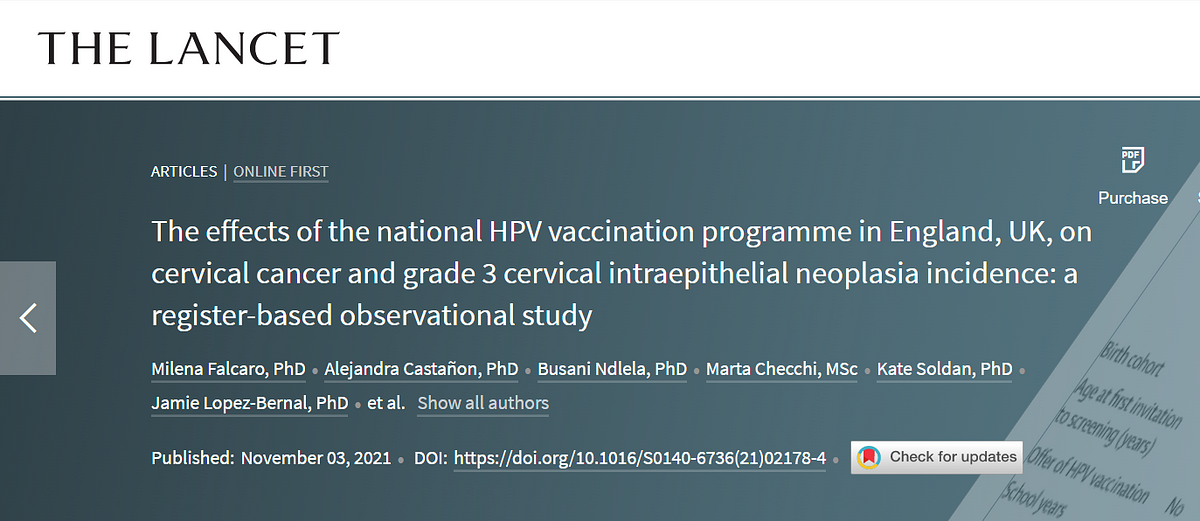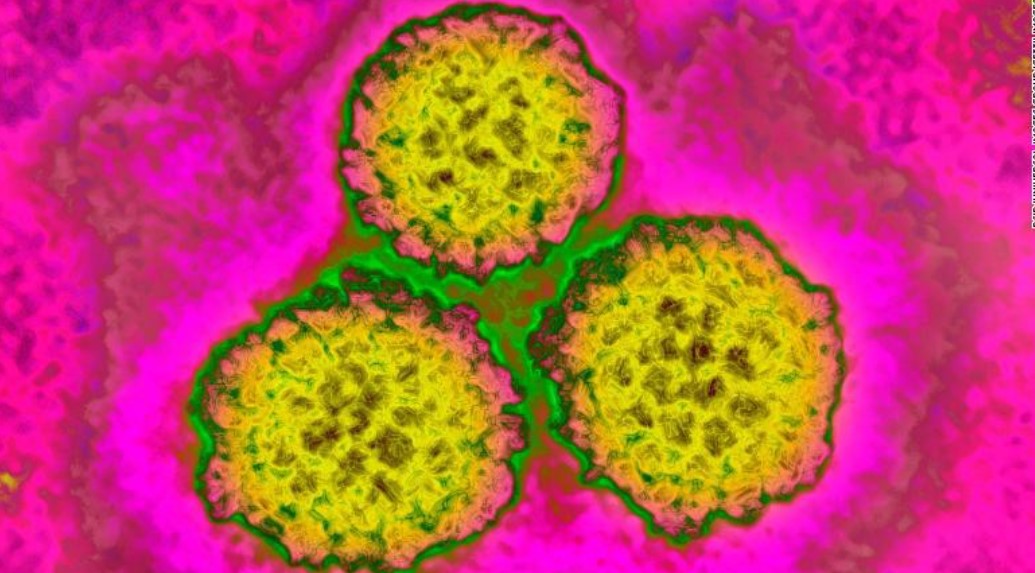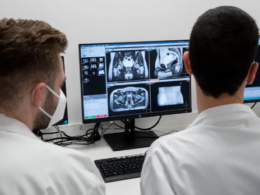CNN
By Jen Christensen
November 4, 2021
Human papillomavirus (HPV) can cause cervical cancer.
(CNN)The first generation HPV vaccine cut cervical cancer rates among women by 87%, British researchers reported.
The study published Wednesday in the journal The Lancet estimates that by mid-2019, there were 450 fewer cases of cervical cancer and 17,200 fewer cases of pre-cancers than expected in the vaccinated population.
Researchers at Kings College London and the British government looked at population-based cancer registry data in the UK between January 2006 and June 2019 for seven groups of women, comparing those who were vaccinated to those who were not.
They were looking at data covering the Cervarix vaccine, which protects against two strains of cancer-causing human papillomavirus or HPV. Newer vaccines sold under the Gardasil brand protect against even more strains of cancer causing viruses.
Of the three groups that were vaccinated, each were vaccinated at different ages. One group was vaccinated at age 12–13, another at 14–16, and another at 16 -18. Those vaccinated at the earliest ages were the most protected, the team reported. Those who got the shot between the ages of 14 and 16 saw an 62% reduced rate, and rates were reduced by 24% among those vaccinated between 16 and 18.
“This study provides the first direct evidence of the impact of the UK HPV vaccination campaign on cervical cancer incidence, showing a large reduction in cervical cancer rates in vaccinated cohorts,” study co-author Dr. Kate Soldan from the UK Health Security Agency said.
“This represents an important step forwards in cervical cancer prevention. We hope that these new results encourage uptake as the success of the vaccination program relies not only on the efficacy of the vaccine but also the proportion of the population vaccinated.”
Cervical cancer is rare among young women, so it is still too early to determine the full impact HPV immunizations have on overall cervical cancer rates. The UK also stopped using the HPV vaccine in this study in 2012. Now instead of the Cervarix vaccine, the UK uses the Gardasil vaccine instead.
Last year the World Health Organization launched the Global Strategy to Accelerate the Elimination of Cervical Cancer, the first-ever global commitment to eliminate cancer, setting a target of getting 90% of girls fully vaccinated against HPV by the time they turn 15.
In January, the US Department of Health and Human Services also launched a campaign to increase HPV vaccination rates. The campaign specifically targeted states with some of the lowest HPV vaccination rates, including South Carolina, Texas and Mississippi.
In 2021, the American Academy of Pediatrics found that the HPV vaccination rates are getting better, but fewer than half of young adults in the US have received one or more doses, and the HPV vaccination rate has not yet caught up to the rate of other vaccines. The CDC began recommending the HPV vaccine for girls 11–12 years old in 2006. A 2021 CDC report found that cervical cancer rates in the US have dropped significantly thanks to the HPV vaccine.
HPV is the most common sexually transmitted virus in the US. While it usually resolves on its own, persistent HPV infection puts women at an increased risk for cervical cancer, cancer in the back of the throat and anogenital cancer. HPV also puts men at an increased risk of anal, penile and throat cancer.
Originally published at https://edition.cnn.com
ORIGINAL PUBLICATION

The effects of the national HPV vaccination programme in England, UK, on cervical cancer and grade 3 cervical intraepithelial neoplasia incidence: a register-based observational study
The Lancet
November 3, 2021
Milena Falcaro, PhD;
Alejandra Castañon, PhD;
Busani Ndlela, PhD;
Marta Checchi, MSc;
Kate Soldan, PhD;
Jamie Lopez-Bernal, PhD;
Lucy Elliss-Brookes, BSc;
Prof Peter Sasieni
Published:November 03, 2021DOI:https://doi.org/10.1016/S0140-6736(21)02178-4
Summary
Background
Human papillomavirus (HPV) immunisation with a bivalent vaccine (Cervarix) was introduced in England, UK, in Sept 1, 2008:
routine vaccination was offered to girls aged 12–13 years with a catch-up programme for females aged 14–18 years in 2008–10.
We quantified the early effect of this immunisation programme on cervical cancer and cervical carcinoma in situ, namely grade 3 cervical intraepithelial neoplasia (CIN3), registrations.
Methods
In this observational study, we used an extension of the age-period-cohort Poisson model to estimate the relative risk of cervical cancer in three vaccinated cohorts compared with earlier cohorts that were not eligible for HPV vaccination.
Data from a population-based cancer registry were extracted on Jan 26, 2021, and were assessed for diagnoses of cervical cancer and CIN3 from Jan 1, 2006 to June 30, 2019 in women aged 20–64 years and who were a resident in England.
We used three vaccinated cohorts to account for differences in the school year in which the vaccine was offered and its national coverage.
Adjustment for confounding was made using information on changes in cervical screening policy and historical events that affected cervical cancer incidence.
Results were compared across models with different adjustments for confounders.
Findings
We used data from a total of 13·7 million-years of follow-up of women aged 20 years to younger than 30 years.
The estimated relative reduction in cervical cancer rates by age at vaccine offer were
- 34% (95% CI 25–41) for age 16–18 years (school year 12–13),
- 62% (52–71) for age 14–16 years (school year 10–11), and
- 87% (72–94) for age 12–13 years (school year 8), compared with the reference unvaccinated cohort.
The corresponding risk reductions for CIN3 were
- 39% (95% CI 36–41) for those offered at age 16–18 years,
- 75% (72–77) for age 14–16 years, and 97% (96–98) for age 12–13 years.
These results remained similar across models.
We estimated that by June 30, 2019 there had been
- 448 (339–556) fewer than expected cervical cancers and
- 17 235 (15 919–18 552) fewer than expected cases of CIN3 in vaccinated cohorts in England.
Interpretation
We observed a substantial reduction in cervical cancer and incidence of CIN3 in young women after the introduction of the HPV immunisation programme in England, especially in individuals who were offered the vaccine at age 12–13 years.
The HPV immunisation programme has successfully almost eliminated cervical cancer in women born since Sept 1, 1995.
Funding
Cancer Research UK.












